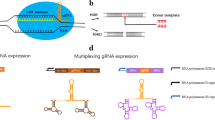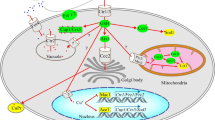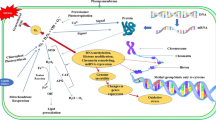Abstract
The cAMP pathway in Schizosaccharomyces pombe is the major nutrient sensing pathway to initiate sexual development when opposite mating type cells exist. We identified moc1–moc4 as genes that overcome a partially sterile S. pombe strain due to an elevation of cAMP. When we compared the strength of inducing ability of sexual development in the same S. pombe strain, Moc1 had highest, Moc2 had lowest, and both Moc3 and Moc4 had intermediate effects. Moc1/Sds23 and Moc2/Ded1 are known to be a potential regulator of M-phase progression and an essential RNA helicase, respectively. While Moc4 was found to be identical with a Zn-finger protein Zfs1, Moc3 (SPAC821.07c) was a novel protein containing a Zn-finger (Zn(2)-Cys(6)) motif. Deletion mutant of the moc3 gene was constructed and its disruptant was found to be lower in mating efficiency and formed aberrant asci. In addition, unexpectedly, a moc3 disruptant was sensitive to CaCl2 and DNA damaging agents such as MMS and UV. Those phenotypes were opposite to the phenotypes observed in a zfs1 disruptant, and quite different from the ones in a moc1 disruptant. Moc3 localized in the nucleus as observed for Zfs1. Moc3 bound with Moc4/Zfs1 weakly in the two hybrid system, but no other combination of Moc(s) bound each other in the same analysis. Thus, Moc3 is not only involved in sexual development, but also in ascus formation and DNA integrity in an independent manner with Moc1 and Moc2 in S. pombe.






Similar content being viewed by others
References
Alfa C, Fantes P, Hyams J, Mcleod M, Warbrick E (1993) Experiments with fission yeast: a laboratory course manual. Cold Spring Harbor Laboratory Press, Cold Spring Harbor, pp 133–136
Beltraminelli N, Murone M, Simanis V (1999) The S. pombe zfs1 gene is required to prevent septation if mitotic progression is inhibited. J Cell Sci 18:3103–3114
Burke D, Dawson D, Stearns T (2000) Methods in yeast genetics; a Cold Spring Harbor Laboratory course manual. Cold Spring Harbor Laboratory Press, Cold Spring Harbor pp 171–182
Devoti J, Seydoux G, Beach D, Mcleod M (1991) Interaction between ran1 + protein kinase and cAMP-dependent protein kinase as negative regulators of fission yeast meiosis. EMBO J 10:3759–3768
Fields S, Song O (1989) A novel genetic system to detect protein-protein interactions. Nature 340:245–247
Forsburg SL, Sherman DA (1997) General purpose tagging vectors for fission yeast. Gene 191:191–195
Gietz RD, Woods RA (1994) High efficiency transformation in yeast, In: Johnson JA (eds) Molecular genetics of yeast: practical approaches. Oxford University Press, Oxford, pp 121–134
Goldar MM, Nishie T, Ishikura Y, Fukuda T, Takegawa K, Kawamukai M (2005) Functional conservation between fission yeast moc1/sds23 and its two orthologs, budding yeast SDS23 and SDS24, and phenotypic differences in their disruptants. Biosci Biotechnol Biochem 69:1422–1426
Higuchi T, Watanabe Y, Yamamoto M (2002) Protein kinase A regulates sexual differentiation and gluconeogenesis through phosphorylation of the Zn finger transcriptional activator Rst2p in fission yeast. Mol Cell Biol 22:1–11
Ishii K, Kumada K, Toda T, Yanagida M (1996) Requirement for PP1 phosphatase and 20S cyclosome/APC for the onset of anaphase is lessened by the dosage increase of a novel gene. EMBO J 15:6629–6640
Isshiki T, Mochizuki N, Maeda T, Yamamoto M (1992) Characterization of a fission yeast gene, gpa2, that encodes a G alpha subunit involved in the monitoring of nutrition. Genes Dev 6:2455–2462
Jeong HT, Ozoe F, Tanaka K, Nakagawa T, Matsuda H, Kawamukai M (2004a) A novel gene, msa1, inhibits sexual differentiation in Schizosaccharomyces pombe. Genetics 167:77–91
Jeong HT, Oowatari Y, Abe M, Tanaka K, Matsuda H, Kawamukai M (2004b) Interaction between a negative regulator (Msa2/Nrd1) and a positive regulator (Cpc2) of sexual differentiation in Schizosaccharomyces pombe. Biosci Biotechnol Biochem 68:1621–1626
Kanoh J, Sugimoto A, Yamamoto M (1995) Schizosaccharomyces pombe zfs1+ encoding a zinc-finger protein functions in the mating pheromone recognition pathway. Mol Biol Cell 6:1185–1195
Katayama S, Ozoe F, Kurokawa R, Tanaka K, Nakagawa T, Matsuda H, Kawamukai M (1996) Genetic analysis of the sam mutations, which induce sexual development with no requirement for nutritional starvation in fission yeast. Biosci Biotechnol Biochem 60:994–999
Kawamukai M (1999) Isolation of a novel gene, moc2, encoding a putative RNA helicase as a suppressor of sterile strains in Schizosaccharomyces pombe. Biochim Biophys Acta 1446:93–101
Kawamukai M, Ferguson K, Wigler M, Young D (1991) Genetic and biochemical analysis of the adenylyl cyclase of Schizosaccharomyces pombe. Cell Regul 2:155–164
Kawamukai M, Gerst J, Field J, Riggs M, Rodgers L, Wigler M, Young D (1992) Genetic and biochemical analysis of the adenylyl cyclase-associated protein, cap, in Schizosaccharomyces pombe. Mol Biol Cell 3:167–180
Kitamura K, Katayama S, Dhut S, Sato M, Watanabe Y, Yamamoto M, Toda T (2001) Phosphorylation of Mei2 and Ste11 by Pat1 kinase inhibits sexual differentiation via ubiquitin proteolysis and 14-3-3 protein in fission yeast. Dev Cell 1:389–399
Krawchuk MD, Wahls WP (1999) High-efficiency gene targeting in Schizosaccharomyces pombe using a modular, PCR-based approach with long tracts of flanking homology. Yeast 15:1419–1427
Kunitomo H, Higuchi T, Iino Y, Yamamoto M (2000) A zinc-finger protein, Rst2p, regulates transcription of the fission yeast ste11 + gene, which encodes a pivotal transcription factor for sexual development. Mol Biol Cell 11:3205–3217
Landry S, Hoffman CS (2001) The git5 Gβ and git11 Gγ form an atypical Gβγ dimer acting in the fission yeast glucose/cAMP pathway. Genetics 157:1159–1168
Liu HY, Nefsky BS, Walworth NC (2002) The Ded1 DEAD box helicase interacts with Chk1 and Cdc2. J Biol Chem 277:2637–2643
Li P, Mcleod M (1996) Molecular mimicry in development: identification of ste11 + as a substrate and mei3 + as a pseudosubstrate inhibitor of ran1 + kinase. Cell 87:869–880
Maeda T, Mochizuki N, Yamamoto M (1990) Adenylyl cyclase is dispensable for vegetative cell growth in the fission yeast Schizosaccharomyces pombe. Proc Natl Acad Sci USA 87:7814–7818
Maeda T, Watanabe Y, Kunitomo H, Yamamoto M (1994) Cloning of the pka1 gene encoding the catalytic subunit of the cAMP-dependent protein kinase in Schizosaccharomyces pombe. J Biol Chem 269:9632–9637
Matsuo Y, Tanaka K, Matsuda H, Kawamukai M (2005) cda1 +, encoding chitin deacetylase is required for proper spore formation in Schizosaccharomyces pombe. FEBS Lett 579:2737–2743
Matsuo Y, Tanaka K, Nakagawa T, Matsuda H, Kawamukai M (2004) Genetic analysis of chs1 + and chs2+ encoding chitin synthases from Schizosaccharomyces pombe. Biosci Biotechnol Biochem 68:1489–1499
Mochizuki N, Yamamoto M (1992) Reduction in the intracellular cAMP level triggers initiation of sexual development in fission yeast. Mol Gen Genet 233:17–24
Moreno S, Klar A, Nurse P (1991) Molecular genetic analysis of fission yeast Schizosaccharomyces pombe. Methods Enzymol 194:795–823
Ozoe F, Kurokawa R, Kobayashi Y, Jeong HT, Tanaka K, Sen K, Nakagawa T, Matsuda H, Kawamukai M (2002) The 14-3-3 proteins Rad24 and Rad25 negatively regulate Byr2 by affecting its localization in Schizosaccharomyces pombe. Mol Cell Biol 22:7105–7119
Prentice HL (1992) High efficiency transformation of Schizosaccharomyces pombe by electroporation. Nucleic Acids Res 20:621
Sambrook J, Fritsch EF, Maniatis T (1989) Molecular cloning: a laboratory manual, 2nd edn. Cold Spring Harbor Laboratory Press, Cold Spring Harbor
Sato M, Watanabe Y, Akiyoshi Y, Yamamoto M (2002) 14-3-3 protein interferes with the binding of RNA to the phosphorylated form of fission yeast meiotic regulator Mei2p. Curr Biol 12:141–145
Sugimoto A, IinoY, Maeda T, Watanabe Y, Yamamoto M (1991) Schizosaccharomyces pombe ste11 + encodes a transcription factor with an HMG motif that is a critical reguulator of sexual development. Genes Dev 5:1990–1999
Tanabe K, Ito N, Wakuri T, Ozoe F, Umeda M, Katayama S, Tanaka K, Matsuda H, Kawamukai M (2003) Sla1, a Schizosaccharomyces pombe homolog of the human La protein, induces ectopic meiosis when its C-terminus is truncated. Eukaryot Cell 2:1274–1287
Tanabe K, Tanaka K, Matsuda H, Kawamukai M (2004) Truncated Sla1 induces haploid meiosis through the Pat1-Mei2 system in fission yeast. Biosci Biotechnol Biochem 68:226–270
Watanabe Y, Yamamoto M (1994) S. pombe mei2 +encodes an RNA-binding protein essential for premeiotic DNA synthesis and meiosis I, which cooperates with a novel RNA species meiRNA. Cell 78:487–498
Watanabe Y, Shimozaki-yabana S, Chikashige Y, Hiraoka Y, Yamamoto M (1997) Phosphorylation of RNA-binding protein controls cell cycle switch from mitotic to meiotic in fission yeast. Nature 386:187–190
Welton RM, Hoffman CS (2000) Glucose monitoring in fission yeast via the Gpa2 Gα, the git5 Gβ and the git3 putative glucose receptor. Genetics 156:513–521
Yamada H, Kumada K, Yanagida M (1997) Distinct subunit functions and cell cycle regulated phosphorylation of 20S APC/cyclosome required for anaphase in fission yeast. J Cell Sci 110:1793–1804
Yakura M, Ozoe F, Ishida H, Nakagawa T, Tanaka K, Matsuda H, Kawamukai M (2005) zds1, a novel gene encoding an ortholog of Zds1 and Zds2, controls sexual differentiation, cell wall integrity, and cell morphology in fission yeast. Genetics (in press)
Yamamoto M (2003) Initiation of meiosis. In: Egel R (ed) The molecular biology of Schizosaccharomyces pombe. Springer, Berlin Heidelberg New York, pp 297–309
Yamamoto M, Imai Y, Watanabe Y (1997) Mating and sporulation in Schizosaccharomyces pombe, In: Pringle JR, Broach JR, Jones EW (eds) The molecular and cellular biology of the yeast Saccharomyces. Cold Spring Harbor Laboratory Press, Cold Spring Harbor, pp 1037–1106
Acknowledgements
We thank C. Hoffman for critical reading and corrections of this manuscript. We thank J. Kanoh and M. Yamamoto for strains. This research was supported by grant-aid from the Ministry of Education, Culture, Sports, Science, and Technology of Japan.
Author information
Authors and Affiliations
Corresponding author
Additional information
Communicated by Masayuki Yamamoto
Rights and permissions
About this article
Cite this article
Goldar, M.M., Jeong, H.T., Tanaka, K. et al. Moc3, a novel Zn finger type protein involved in sexual development, ascus formation, and stress response of Schizosaccharomyces pombe . Curr Genet 48, 345–355 (2005). https://doi.org/10.1007/s00294-005-0028-z
Received:
Revised:
Accepted:
Published:
Issue Date:
DOI: https://doi.org/10.1007/s00294-005-0028-z




